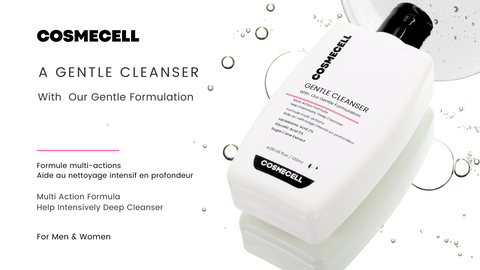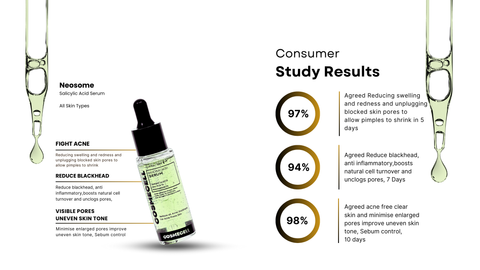Understanding Gentle Facial Cleansers
The quest for radiant skin begins with a fundamental step: cleansing. But not all facial cleansers are created equal. Gentle facial cleansers stand apart as formulations designed to purify the skin without disrupting its natural balance. Unlike their harsher counterparts, these cleansers delicately remove impurities, excess sebum, and environmental pollutants while preserving the skin's essential moisture barrier.
The distinction lies in their composition—gentle cleansers typically eschew aggressive surfactants, synthetic fragrances, and potentially irritating alcohols. Instead, they embrace soothing botanical extracts, mild surfactants, and humectants that cleanse effectively while maintaining skin harmony. This equilibrium is paramount for all skin types, but especially for those with sensitive, reactive, or compromised skin conditions.
The Science Behind Gentle Cleansing
At a microscopic level, gentle cleansers work through a principle called selective cleansing—removing unwanted substances while leaving beneficial elements intact. The skin's acid mantle, a delicate film with a pH of approximately 5.5, serves as a protective barrier against pathogens and environmental stressors. Harsh cleansers with alkaline pH can disrupt this mantle, leading to increased transepidermal water loss, inflammation, and susceptibility to irritants.
Gentle formulations maintain a pH closer to the skin's natural state, preserving the integrity of this crucial defense system. Furthermore, they often incorporate biomimetic ingredients—compounds that mimic the skin's natural structures and functions—enabling cleansing without compromising dermal health. This scientific approach results in purification without provocation, allowing the skin to maintain its intrinsic resilience and luminosity.
Benefits of Using Gentle Facial Cleansers
Incorporating gentle facial cleansers into your skincare regimen yields multifaceted benefits that extend beyond mere cleanliness. These formulations serve as the cornerstone of skin health, establishing the foundation upon which other skincare products can function optimally. For individuals across the spectrum of skin types—from oily to dry, sensitive to resilient—gentle cleansers offer customized cleansing without compromising skin integrity.
The immediate advantage is evident in post-cleanse comfort. Unlike aggressive formulations that leave skin feeling taut, stripped, or irritated, gentle cleansers impart a sensation of refreshment without discomfort. This pleasant experience encourages consistent use, a critical factor in maintaining skin clarity and health over time.
Preserving Skin's Natural Moisture
Perhaps the most significant benefit of gentle cleansers lies in their preservation of the skin's natural moisture balance. The stratum corneum, our outermost skin layer, contains natural moisturizing factors (NMFs) and lipids that maintain hydration and prevent water loss. Harsh cleansers can strip away these essential components, leading to dehydration, increased sensitivity, and accelerated aging.
Gentle formulations respect this delicate ecosystem, removing impurities while leaving beneficial lipids intact. This conservation of natural moisture translates to skin that remains supple, resilient, and radiant throughout the day. For those battling persistent dryness or dehydration, switching to a gentle cleanser often proves transformative, restoring comfort and vitality to previously compromised skin.
"The integrity of the skin barrier is paramount to overall skin health. A gentle cleanser that respects this barrier is not merely a cosmetic choice—it's a health decision with long-term implications for your skin's appearance and function."
Top Gentle Facial Cleansers for All Skin Types
The market abounds with gentle facial cleansers claiming superiority, yet certain formulations genuinely stand apart through their exceptional ingredient profiles and proven efficacy. These standout products have earned devotion among dermatologists, skincare enthusiasts, and individuals with even the most sensitive complexions. Let's explore these remarkable cleansers that deliver purification without compromise.
Cream and Milk-Based Cleansers
Cream and milk-based cleansers represent the epitome of gentle purification, utilizing emollient textures to dissolve impurities while simultaneously nourishing the skin. These formulations excel particularly for those with dry, mature, or sensitive skin conditions. Their lipid-rich composition mimics the skin's natural structures, allowing for effective cleansing without disrupting the epidermal barrier.
Notable contenders in this category include formulations enriched with ceramides, glycerin, and botanical oils. These ingredients not only cleanse but actively replenish the skin's moisture reserves. The application technique matters significantly with these cleansers—massaging gently onto dry skin before emulsifying with water maximizes their cleansing efficacy while maintaining their nourishing properties.
Gel and Foam Cleansers for Sensitive Skin
For those who prefer a more traditional cleansing experience with lather, modern gel and foam cleansers have evolved dramatically from their potentially drying predecessors. Today's gentle versions utilize amino acid-derived surfactants or glucosides that generate satisfying foam without stripping effects. These formulations particularly benefit combination and oily skin types seeking thorough cleansing without overdrying.
The most advanced products in this category incorporate humectants like hyaluronic acid and aloe vera to ensure moisture retention during the cleansing process. Some innovative formulations also feature prebiotics that support the skin's microbiome—the community of beneficial organisms residing on our skin surface that contributes to barrier function and immune protection.
Micellar Waters and Cleansing Waters
The revolution of micellar technology has introduced exceptionally gentle cleansing options that require no rinsing, making them ideal for sensitive skin and convenient for travel or quick cleansing scenarios. These solutions contain microscopic oil molecules (micelles) suspended in soft water, which attract and encapsulate impurities and makeup without aggressive scrubbing.
Premium micellar waters often incorporate soothing agents like thermal spring water, chamomile extract, or cucumber essence to further enhance their gentle profile. While traditionally used with cotton pads, eco-conscious consumers now apply these cleansers with reusable bamboo or organic cotton rounds to minimize environmental impact while maintaining effective cleansing.
How to Choose the Right Gentle Cleanser
Selecting the optimal gentle cleanser requires consideration of multiple factors beyond marketing claims or aesthetic preferences. This decision should be informed by a nuanced understanding of your skin's specific needs, the product's ingredient composition, and environmental considerations. Let's explore the essential criteria for making an educated selection.
Identifying Your Skin Type and Concerns
The foundation of effective cleanser selection begins with an accurate assessment of your skin type. Beyond the traditional categories of dry, oily, combination, or normal, consider your skin's sensitivity level, tendency toward specific conditions (acne, rosacea, eczema), and seasonal variations in its behavior. Skin diagnosis apps or professional consultations can provide valuable insight if you're uncertain about your classification.
Those with oily or acne-prone skin should seek gentle foaming formulations containing non-comedogenic ingredients like niacinamide or tea tree oil. Dry or mature skin benefits from cream cleansers enriched with lipid-replenishing compounds such as squalane or ceramides. Sensitive or reactive skin requires minimalist formulations free from common irritants, potentially incorporating anti-inflammatory agents like centella asiatica or green tea.
Understanding Ingredient Lists
Deciphering ingredient declarations empowers you to make informed decisions regardless of marketing claims. In evaluating gentle cleansers, scrutinize both what is included and what is excluded. Beneficial inclusions in truly gentle formulations often feature:
- Mild surfactants (sodium cocoyl isethionate, cocamidopropyl betaine)
- Humectants (glycerin, hyaluronic acid, panthenol)
- Skin-identical ingredients (ceramides, cholesterol, fatty acids)
- Anti-inflammatory botanicals (calendula, oat extract, licorice root)
Equally important is the absence of potentially problematic ingredients like sulfates (SLS/SLES), artificial fragrances, essential oils (particularly for sensitive skin), and denatured alcohols which can compromise skin barrier function over time.
| Skin Type | Recommended Cleanser Type | Key Ingredients to Look For |
|---|---|---|
| Dry/Mature | Cream or Oil | Ceramides, Squalane, Glycerin |
| Oily/Acne-Prone | Gel or Foam | Niacinamide, Zinc PCA, Gluconolactone |
| Sensitive/Reactive | Micellar or Milk | Centella Asiatica, Allantoin, Colloidal Oatmeal |
| Combination | Balanced Gel or Lotion | Amino Acid Surfactants, Panthenol, Aloe |
Best Practices for Using Gentle Facial Cleansers
Maximizing the benefits of gentle facial cleansers extends beyond product selection to encompass proper application techniques and complementary skincare practices. Even the most meticulously formulated cleanser can underperform if utilized incorrectly. Implementing these expert-recommended strategies will enhance your cleansing experience and optimize skin health outcomes.
Proper Cleansing Techniques
The art of facial cleansing involves more nuance than many realize. Begin with clean hands to prevent introducing additional contaminants to the face. For most gentle cleansers, tepid water proves optimal—hot water can strip natural oils while cold water may prevent proper emulsification of the product. The duration matters significantly; allow approximately 60 seconds of gentle massage to permit active ingredients to interact with the skin surface effectively.
Technique varies by formulation type: cream cleansers benefit from application to dry skin with subsequent emulsification using fingertips, while gel formulations typically perform best when activated with water from the outset. Pay particular attention to often-neglected areas such as the hairline, jawline, and nasolabial folds where residue commonly accumulates. When rinsing, ensure thorough removal of all cleanser residue which could otherwise cause irritation or impede the performance of subsequent skincare products.
Frequency and Timing Considerations
The optimal cleansing frequency depends on individual skin characteristics and environmental factors. While conventional wisdom suggests twice-daily cleansing, those with very dry or sensitive skin may benefit from using water alone in the morning and reserving cleansing for evening use. Conversely, individuals in highly polluted environments or those who perspire significantly may require additional gentle cleansing throughout the day.
Timing your cleansing ritual strategically enhances its effectiveness. Evening cleansing should occur early enough to allow subsequent skincare products to absorb before sleep, while morning cleansing might be scheduled to remove any accumulated nighttime products or perspiration. Seasonal adjustments may also prove beneficial—increasing cleansing frequency during humid summer months while potentially decreasing during dry winter conditions.
Common Misconceptions About Facial Cleansing
Despite the wealth of skincare information available, persistent myths regarding facial cleansing continue to influence consumer behavior and potentially compromise skin health. Dispelling these misconceptions is essential for establishing effective cleansing practices and realistic expectations regarding product performance.
Debunking Myths About Squeaky Clean Skin
Perhaps the most pervasive cleansing misconception is the notion that effective cleansing should result in a "squeaky clean" sensation. This tactile feedback actually indicates potential overcleansing—the squeaking sound and feeling originate from the removal of the skin's natural lipids, leaving it vulnerable to dehydration, irritation, and paradoxical oil overproduction. Healthy post-cleanse skin should feel comfortable, neither tight nor greasy, reflecting preserved barrier function rather than stripped sebum.
Another prevalent fallacy involves equating foam or lather quantity with cleansing efficacy. In reality, abundant foam often correlates with aggressive surfactants that can compromise skin integrity. Modern gentle cleansers may produce minimal lather while effectively dissolving impurities through advanced surfactant technologies and emulsification mechanisms that don't rely on traditional foaming action. Understanding this distinction empowers consumers to select truly gentle formulations rather than being misled by sensorial characteristics that don't correlate with skin-friendly cleansing.
Frequently Asked Questions About Gentle Facial Cleansers
Addressing Common Concerns
Below are answers to frequently asked questions about gentle facial cleansers to help enhance your understanding and optimize your skincare routine:
Can gentle cleansers effectively remove makeup?
Many gentle cleansers can adequately remove light makeup, particularly when used with proper technique and sufficient contact time. However, for waterproof or long-wearing cosmetics, a dedicated makeup remover followed by gentle cleansing often proves more effective without requiring aggressive rubbing or repeated cleansing that might irritate the skin.
How can I determine if my cleanser is truly gentle?
Beyond examining ingredient lists, observe your skin's response after cleansing. Truly gentle formulations shouldn't cause redness, tightness, or discomfort. Consider measuring your cleanser's pH using test strips—ideally, it should fall between 4.5-6.0 to align with skin's natural acidity. For definitive assessment, dermatologists can perform specialized testing to evaluate a product's potential for barrier disruption.
Is double cleansing necessary when using gentle cleansers?
Double cleansing can benefit those wearing sunscreen, foundation, or exposed to significant environmental pollutants. The first cleanse, typically with an oil-based product, dissolves oil-soluble impurities, while the second gentle water-based cleanse removes remaining residue. However, those with extremely sensitive or dry skin may find single cleansing with an appropriate gentle formulation sufficient to maintain skin health without risking overcleansing.
Understanding these nuances about gentle facial cleansers can transform your skincare routine from a mechanical habit to an informed practice that genuinely supports skin health. By selecting products aligned with your specific needs and utilizing them correctly, you can achieve the radiant complexion that reflects truly nurtured skin.



